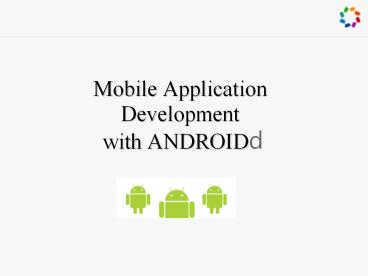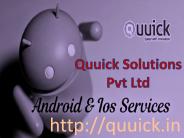Mobile Application Development with ANDROIDd - PowerPoint PPT Presentation
Title:
Mobile Application Development with ANDROIDd
Description:
Mobile Application Development with ANDROIDd What is Android? A software platform and operating system for mobile devices Based on the Linux kernel Developed by ... – PowerPoint PPT presentation
Number of Views:318
Avg rating:3.0/5.0
Title: Mobile Application Development with ANDROIDd
1
- Mobile Application Development with ANDROIDd
2
Introduction
- What is Android?
- A software platform and operating system for
mobile devices - Based on the Linux kernel
- Developed by Google and later the Open Handset
Alliance (OHA) - Allows writing managed code in the Java language
- Unveiling of the Android platform was announced
on 5 November 2007 with the founding of OHA
3
History of Android
- Google acquired the startup company Android Inc.
in 2005 to start the development of the Android
Platform. The key players at Android Inc.
included Andy Rubin, Rich Miner, Nick Sears, and
Chris White. - In late 2007, a group of industry leaders came
together around the Android Platform to form the
Open Handset Alliance (http//www.openhandsetalli
ance.com). - The Android SDK was first issued as an early
look release in November 2007. - In September 2008 T-Mobile announced the
availability of the T-Mobile G1, the first
smartphone based on the Android Platform. - A few days after that, Google announced the
availability of Android SDK Release Candidate
1.0. - In October 2008, Google made the source code of
the Android Platform available under Apaches
open source license.
4
History of Android
5
What is Open Handset Alliance?
- Quoting from www.OpenHandsetAlliance.com page
- Open Handset Alliance, a group of 47
technology and mobile companies have come
together to accelerate innovation in mobile and
offer consumers a richer, less expensive, and
better mobile experience. - Together we have developed Android, the first
complete, open, and free mobile platform. - We are committed to commercially deploy handsets
and services using the Android Platform.
6
Introduction
- What is the Open Handset Alliance (OHA)?
- ? It's a consortium of several companies
Google Android
7
Open Handset Alliance Members
8
Phones
HTC G1, Droid, Tattoo
Motorola Droid (X)
Sony Ericsson
Suno S880
Samsung Galaxy
_at_2010 Mihail L. Sichitiu
8
9
Tablets
Velocity Micro Cruz
Gome FlyTouch
Acer beTouch
Toshiba Android SmartBook
Cisco Android Tablet
Dawa D7
_at_2010 Mihail L. Sichitiu
9
10
Platform
Hardware Android is not a single piece of
hardware it's a complete, end-to-end software
platform that can be adapted to work on any
number of hardware configurations. Everything is
there, from the bootloader all the way up to the
applications.
Google Android
11
Androids Context Mobile Market Player
- Stakeholders
- Mobile network operators want to lock down their
networks, controlling and metering traffic. - Device manufacturers want to differentiate
themselves with features, reliability, and price
points. - Software vendors want complete access to the
hardware to deliver cutting-edge applications.
12
The Maturing Mobile Experience
- Tomorrow?
13
The Maturing Mobile Experience
14
Android vs. Competitors
15
Platform - The Android Software Stack
_at_2010 Mihail L. Sichitiu
15
16
Android S/W Stack - Application
- Android provides a set of core applications
- Email Client
- SMS Program
- Calendar
- Maps
- Browser
- Contacts
- Etc
- All applications are written using the Java
language.
_at_2010 Mihail L. Sichitiu
16
17
Android S/W Stack App Framework
- Most of the application framework accesses these
core libraries through the Dalvik VM, the gateway
to the Android Platform
_at_2010 Mihail L. Sichitiu
17
18
Android S/W Stack App Framework (Cont)
Feature Role
View System Used to build an application, including lists, grids, textboxes, buttons, and embedded web browser
Content Provider Enabling applications to access data from other applications or to share their own data
Resource Manager Providing access to non-code resources (localized string, graphics, and layout files)
Notification Manager Enabling all applications to display customer alerts in the status bar
Activity Manager Managing the lifecycle of applications and providing a common navigation backstack
_at_2010 Mihail L. Sichitiu
18
19
Location Manager
20
Notification Manager
21
Notification Manager
- How background app interact with users
- Consistent notification presentation
22
View System
23
View System
24
Android S/W Stack - Libraries
- Including a set of C/C libraries used by
components of the Android system - Exposed to developers through the Android
application framework
_at_2010 Mihail L. Sichitiu
24
25
Android S/W Stack - Libraries
- The media libraries are based on PacketVideos
(http//www.packetvideo.com/) OpenCORE. These
libraries are responsible for recording and
playback of audio and video formats. - A library called Surface Manager controls access
to the display system and supports 2D and 3D. - The WebKit library is responsible for browser
support it is the same library that supports
Google Chrome and Apple Inc.s Safari. - The FreeType library is responsible for font
support. - SQLite (http//www.sqlite.org/) is a relational
database that is available on the device itself.
SQLite is also an independent open source effort
for relational databases and not directly tied to
Android. You can acquire and use tools meant for
SQLite for Android databases as well.
26
Android S/W Stack - Runtime
- Core Libraries
- Providing most of the functionality available in
the core libraries of the Java language - APIs
- Data Structures
- Utilities
- File Access
- Network Access
- Graphics
- Etc
_at_2010 Mihail L. Sichitiu
26
27
The Dalvik runtime is optimised for mobile
applications
- Run multiple VMs efficiently
Each app has its own VM
Minimal memory footprint
28
Android S/W Stack Runtime (Cont)
- Dalvik Virtual Machine (Cont)
- Executing the Dalvik Executable (.dex) format
- .dex format is optimized for minimal memory
footprint. - Compilation
- Relying on the Linux Kernel for
- Threading
- Low-level memory management
_at_2010 Mihail L. Sichitiu
28
29
Android applications are compiled to Dalvik
bytecode
Write app in Java
Compiled in Java
Transformed to Dalvik bytecode
30
Android S/W Stack Linux Kernel
- Relying on Linux Kernel 2.6 for core system
services - Memory and Process Management
- Network Stack
- Driver Model
- Security
- The supplied device drivers include Display,
Camera, Keypad, WiFi, Flash Memory, Audio, and
IPC (interprocess communication). - Providing an abstraction layer between the H/W
and the rest of the S/W stack
_at_2010 Mihail L. Sichitiu
30
31
Platform
- Network Connectivity
- It supports wireless communications using
- GSM mobile-phone technology
- 3G
- Edge
- 802.11 Wi-Fi networks
Google Android
32
Software development
- Development requirements
- Java
- Android SDK
Google Android
33
Software development
- IDE and Tools
- Android SDK
- Class Library
- Developer Tools
- Emulator and System Images
- Documentation and Sample Code
- Eclipse IDE ADT (Android Development Tools)
- Reduces Development and Testing Time
- Makes User Interface-Creation easier
- Makes Application Description Easier
Google Android
34
Advantages
- Here are a few other advantages Android offers
you as a developer - The Android SDK is available for Windows, Mac
and Linux, so you dont need to pay for new
hardware to start writing applications. - An SDK built on Java. If youre familiar with
the Java programming language, youre already
halfway there. - By distributing your application on Android
Market, its available to hundreds of thousands
of users instantly. Youre not just limited to
one store, because there are alternatives, too.
For instance, you can release your application on
your own blog. Amazon have recently been rumoured
to be preparing their own Android app store also. - As well as the technical SDK documentation,
new resources are being published for Android
developers as the platform gains popularity among
both users and developers.
Google Android
35
Application Building Blocks
- Activity
- IntentReceiver
- Service
- ContentProvider
36
Activities
- Typically correspond to one UI screen
- But, they can
- Be faceless
- Be in a floating window
- Return a value
37
IntentReceivers
- Components that respond to broadcast Intents
- Way to respond to external notification or alarms
- Apps can invent and broadcast their own Intent
38
Intents
- Think of Intents as a verb and object a
description of what you want done - E.g. VIEW, CALL, PLAY etc..
- System matches Intent with Activity that can best
provide the service - Activities and IntentReceivers describe what
Intents they can service
39
Intents
Photo Gallery
Home
Picasa
Contacts
Pick photo
GMail
Chat
Blogger
Blogger
40
Services
- Faceless components that run in the background
- E.g. music player, network download etc
41
ContentProviders
- Enables sharing of data across applications
- E.g. address book, photo gallery
- Provides uniform APIs for
- querying
- delete, update and insert.
- Content is represented by URI and MIME type































